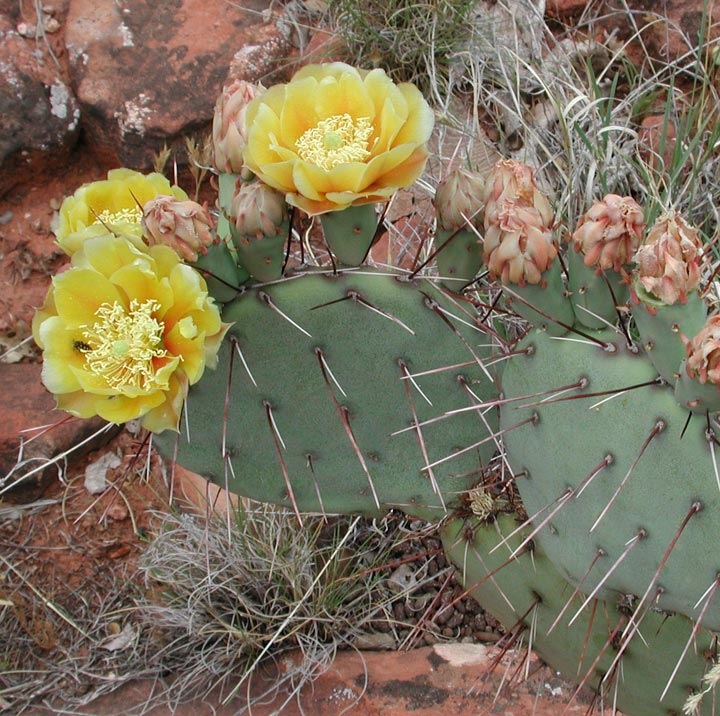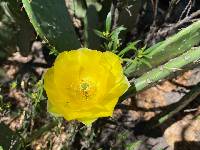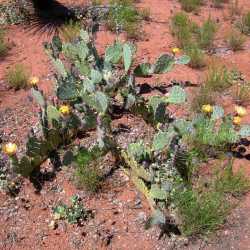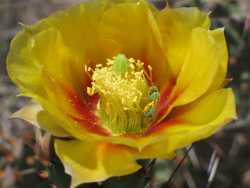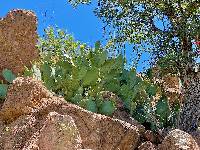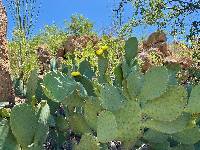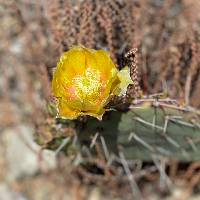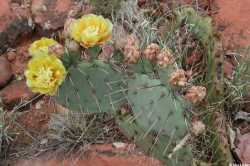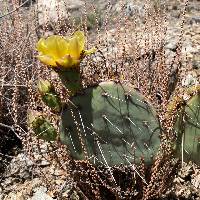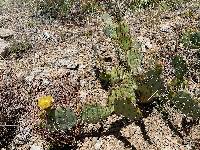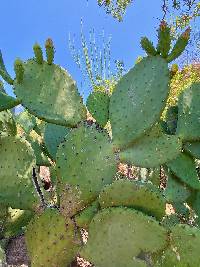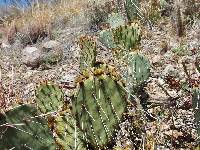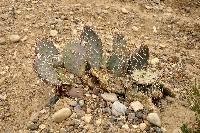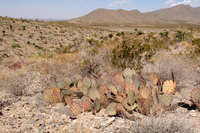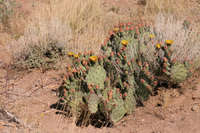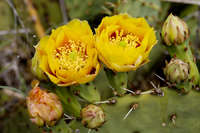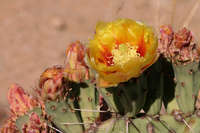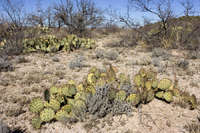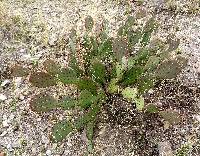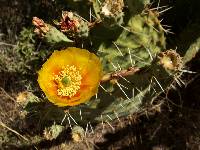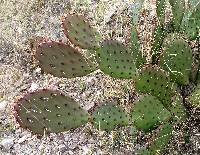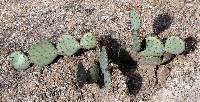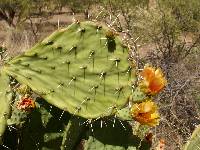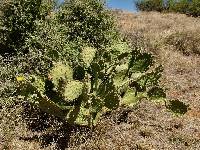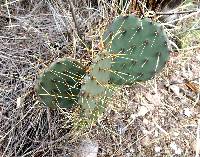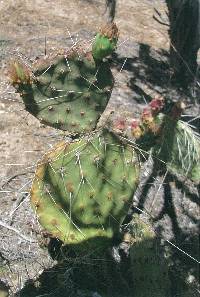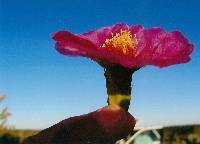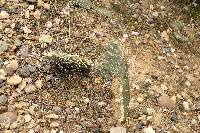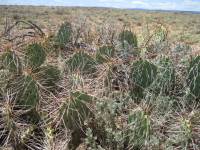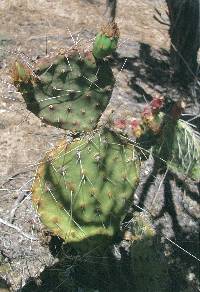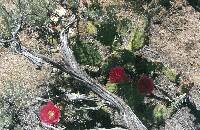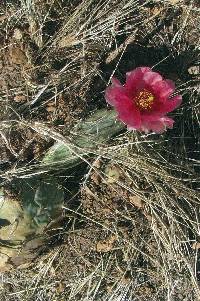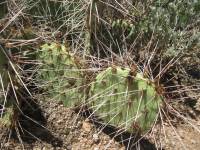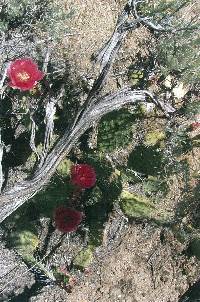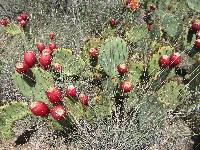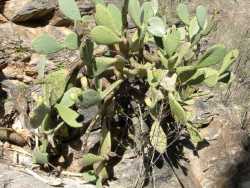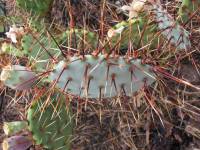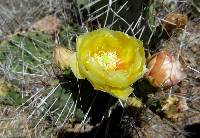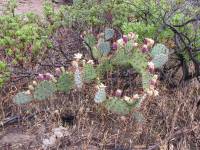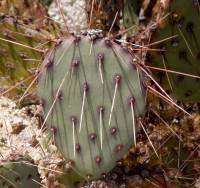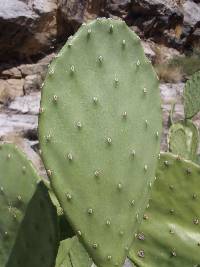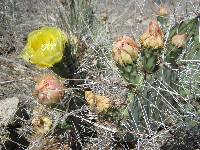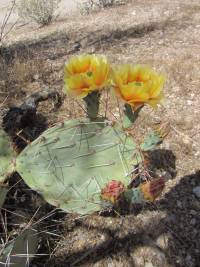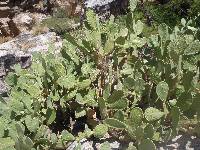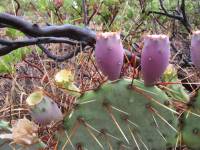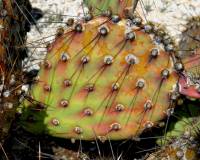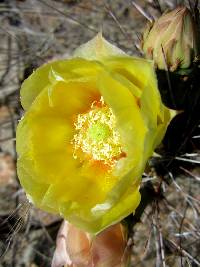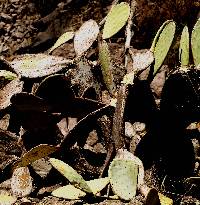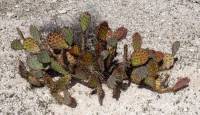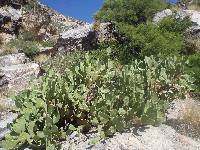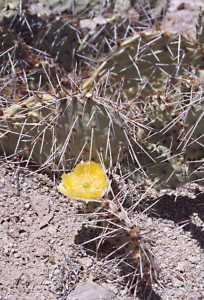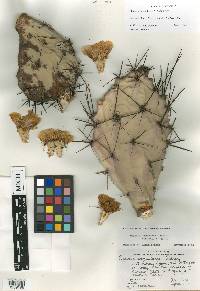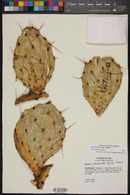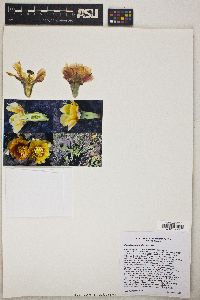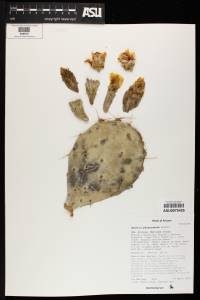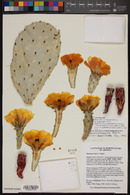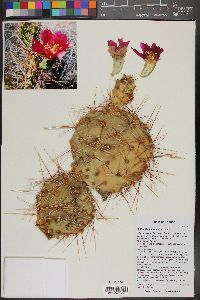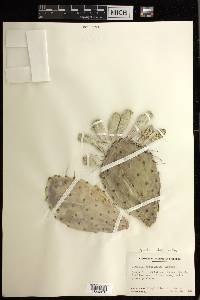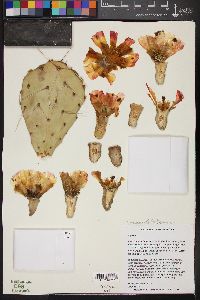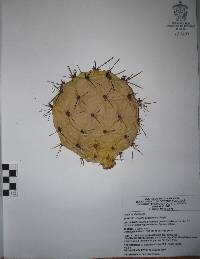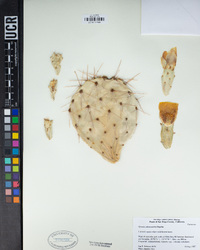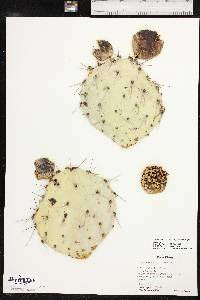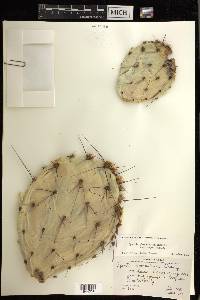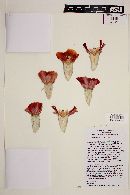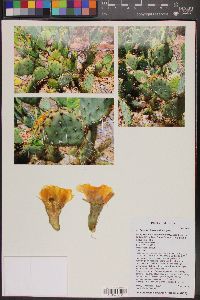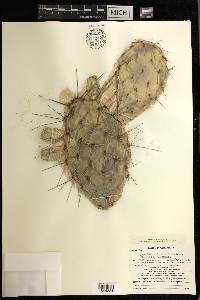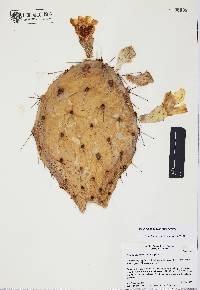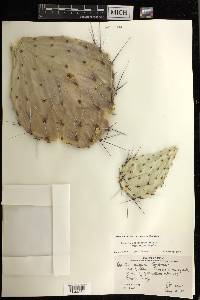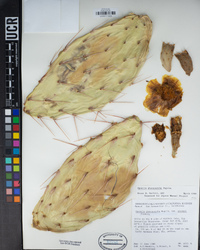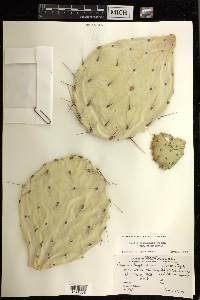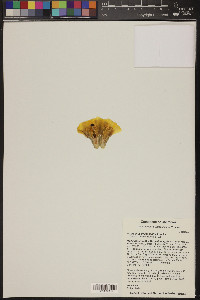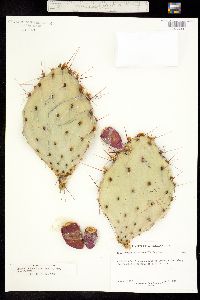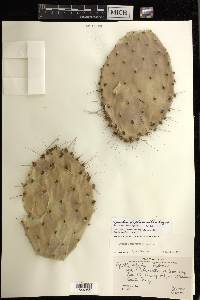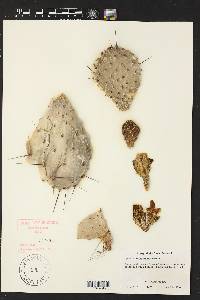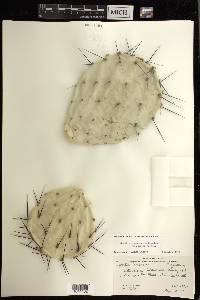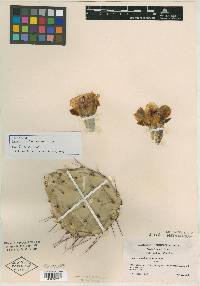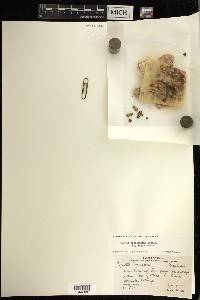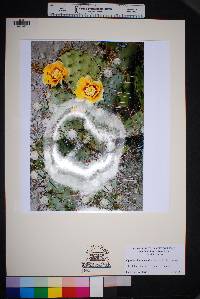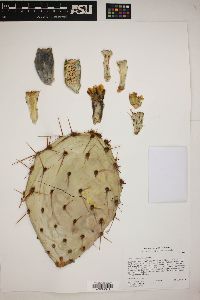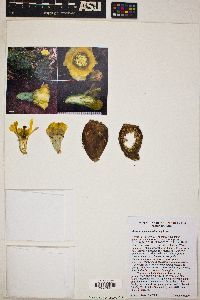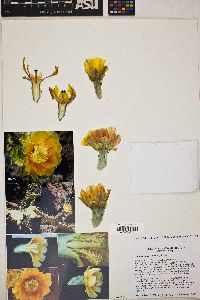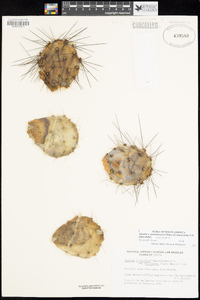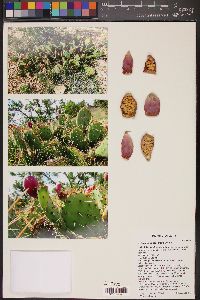Opuntia phaeacantha
|
|
|
|
Family: Cactaceae
Dark-spined pricklypear, more...Tulip Prickly-Pear, Brownspine pricklypear, Tulip pricklypear (es: nopal)
[Opuntia camanchica Engelm. & J.M.Bigelow, moreOpuntia charlestonensis Clokey, Opuntia phaeacantha var. camanchica (Engelm. & J.M.Bigelow) L.D.Benson] |
Shrubs, decumbent to commonly trailing, 0.3-1 m. Stem segments not disarticulating, green to dark green, sometimes reddish under stress, flattened, obovate to circular, 10-25 × 7-20 cm, low tuberculate, glabrous; areoles 5-7 per diagonal row across midstem segment, obovate to elliptic, 3-6 × 2-4 mm; wool tan to brown, aging grayish. Spines (0-)2-8 per areole, at most areoles to only distal 1/4 of stem segment, or essentially absent, brown to white, straight, curved, or spirally twisted; major central spines deflexed or spreading, brown to red-brown (to blackish), or partly to wholly gray to tan, subulate, usually flattened near base, 30-80 mm; abaxial spines usually 1-3, deflexed, white, flattened, shorter, to 20 mm. Glochids dense in crescent at adaxial edge of areole and subapical tuft, tan to red-brown, to 5 mm. Flowers: inner tepals yellow with red basal portions (rarely entirely pink to red), 30-40 mm; filaments greenish basally, pale yellow to white distally; anthers yellow; style white; stigma lobes green to yellow-green. Fruits wine red to purple, with greenish flesh (sometimes reddish and ± juicy), not long stipitate, obovate to barrel-shaped, 30-50 × 20-30 mm, fleshy, glabrous, spineless; areoles 18-24. Seeds tan, subcircular, 4-5 mm diam., evidently notched, warped; girdle protruding 1 mm. 2n = 66. Flowering late spring (Apr-Jul). Deserts, chaparral, surrounding mountains, plains, sandy to rocky soils; 200-2100 m; Ariz., Calif., Colo., Kans., Nev., N.Mex., Okla., Tex., Utah; Mexico. Much of the material formerly assigned to varieties of Opuntia phaeacantha has been segregated as O. engelmannii. Various combinations of overlapping character states make separation of O. phaeacantha var. major from var. phaeacantha impractical. Presumably var. major comprises sprawling to erect shrubs with obovate stem segments bearing usually few darker colored spines (usually one to three) per areole, in the distal half of the stem segment or less, whereas plants of var. phaeacantha are trailing shrubs with narrowly obovate stem segments bearing more spines (usually three to ten) per areole throughout most to all of the stem segment. Recently some workers have applied O. camanchica Engelmann & Bigelow to those plants with the very dark colored spines and merged vars. major and phaeacantha. Distinctions among taxa are further blurred by hybridization of O. phaeacantha with O. engelmannii, yielding several named and unnamed hybrids, including O. wootonii Griffiths. Morphologic and genetic analyses of the populations are needed before correct names can be assigned to many of these plants with confidence. Opuntia phaeacantha also hybridizes with O. aureispina (forming O. ×spinosibacca), O. ficus-indica, and O. littoralis (forming O. ×vaseyi), and members of the O. polyacantha complex, particularly near the regions of Grand Canyon and Four Corners.
Plant: Shrubs decumbent to commonly trailing, 0.3-1 m tall. PADS green to dark-green, glabrous, obovate to circular, 10-25 cm long, 7-20 cm broad. AREOLES 5-7 in a row diagonal across midpad, obovate to elliptic to circular, 10-25 mm long, 7-20 mm wide; wool tan to brown, aging grayish Leaves: SPINES at most areoles to only distal fourth of pad surface, or essentially absent, brown to white, (0-)2-8 per areole; central spines straight or curved, brown to red-brown (to blackish), partly to wholly chalky-white, subulate, usually flattened at base, 3.5-7 cm long; lowermost basal spines usually 1(-3), deflexed, shorter to 2 cm long, whitish, often the only spines in pad-s basal areoles, flattened. GLOCHIDS tan to red-brown, dense in an apical crescent and a subapical tuft, to 8 mm long Flowers: inner tepals yellow with red basal portions, rarely entirely pink to red, 3-4 cm long; filaments greenish below, pale yellow to white above; style white; fresh stigmas green to yellow-green Fruit: FRUITS wine-red to purple, with greenish flesh (sometimes juicy in age), obovate to barrel-shaped, not long-stipitate, spineless, 3-5 cm long, 2-3 cm in diameter; areoles 15-40. SEEDS tan, subcircular, 4-5 mm in diameter, notched, warped; girdle protruding ca. 1 mm Misc: Sandy to rocky soils, deserts, surrounding mountains, plains; 600-2100 m (2000-6900 ft); Apr-Jun REFERENCES: Pinkava, Donald J. Cactaceae. 2003. J. Ariz. - Nev. Acad. Sci. Volume 35(2). Benson 1982, FNA 2004, Pinkava 2003, Allred and Ivey 2012, Heil et al. 2013 Common Name: tulip pricklypear Duration: Perennial Protected Status: Salvage restriced status in Arizona. Spines: Spines emerge from obovate to elliptic, tan to brown areoles which turn gray with age; spines present at most areoles or sometimes only on the upper quarter of each pad; when present, spines 2-8 per areole, with the largest spines 3-7 cm long, usually deflexed, straight or curved, and distinctly wide and flat at the base, the color brown to red-brown or chalky white; each areole has a crescent-shaped patch of tan to red-brown glochids (fine barbed bristles), up to 5 mm long. Flowers: Petals numerous, yellow with red near the base, or occasionally entirely pink or red, 3-4 cm long; stamens numerous, with filaments that are greenish near the base and pale yellow to white near the top; style white, topped with a ring of green to yellow-green stigma lobes. Fruits: Fruits fleshy, wine-red to purple on the outside and with greenish or reddish flesh in the inside, spineless, obovate to barrel-shaped, 3-5 cm long by 2-3 cm wide, with about 20 areoles; seeds round, tan-colored, 4-5 mm wide. Ecology: Found on sandy to rocky soils, below 7,000 ft (2134 m), flowers April-June. Distribution: s CA, s NV, s UT, AZ, CO, NM, s KS, OK, TX, SD; south to n MEX. Notes: This is a notoriously variable species within a notoriously confusing and much-hybridizing genus. Several former varieties were recently re-assigned to O. engelmannii, a species with which this taxon is known to hybridize. Distinguish O. phaeacantha by the usually sprawling, decumbent growth form; pads turning reddish (or occasionally purplish) after stress; dense glochids at each areole; the usually downward-pointing brown spines; flower petals that are yellow with reddish-peach bases or reddish throughout; and the fleshy fruits with skin the color of red wine and often greenish flesh if you cut them open. Distinguished from the similar O. engelmanii by the trailing growth form, usually smaller pads (15-40 cm long in O. engelmannii vs. 10-25 cm in this species), density of glochids, and the flower color (O. engelmannii has yellow to red flowers but not bicolored). Also similar to O. macrocentra, which shares the trait of bicolor yellow and red flower petals; distinguish from that species based on spine length (O. macrocentra can often have much longer spines, up to 17 cm long); and the spine shape, which is quite flattened in this species but mostly round in cross section with a slightly flattened base on O. macrocentra; O. macrocentra is also much more likely to have purple-tinted pads. Ethnobotany: The fruit is edible and is eaten fresh or dried, made into jams, jellies, juice and wine; pads are also edible and were prepared by roasting, boiling, or pulping and making into cakes; the seeds were ground into flour, although some say that prickly pear seeds are toxic and should not be eaten in quantity. Etymology: Opuntia is from the Latin root puncti for prickled; phaeacantha is from the Greek root phaeo for dark or dusky and akantha, thorn. Synonyms: Opuntia superbospina Editor: SBuckley 2010, FSCoburn 2015, AHazelton 2017 |
|
|
|

